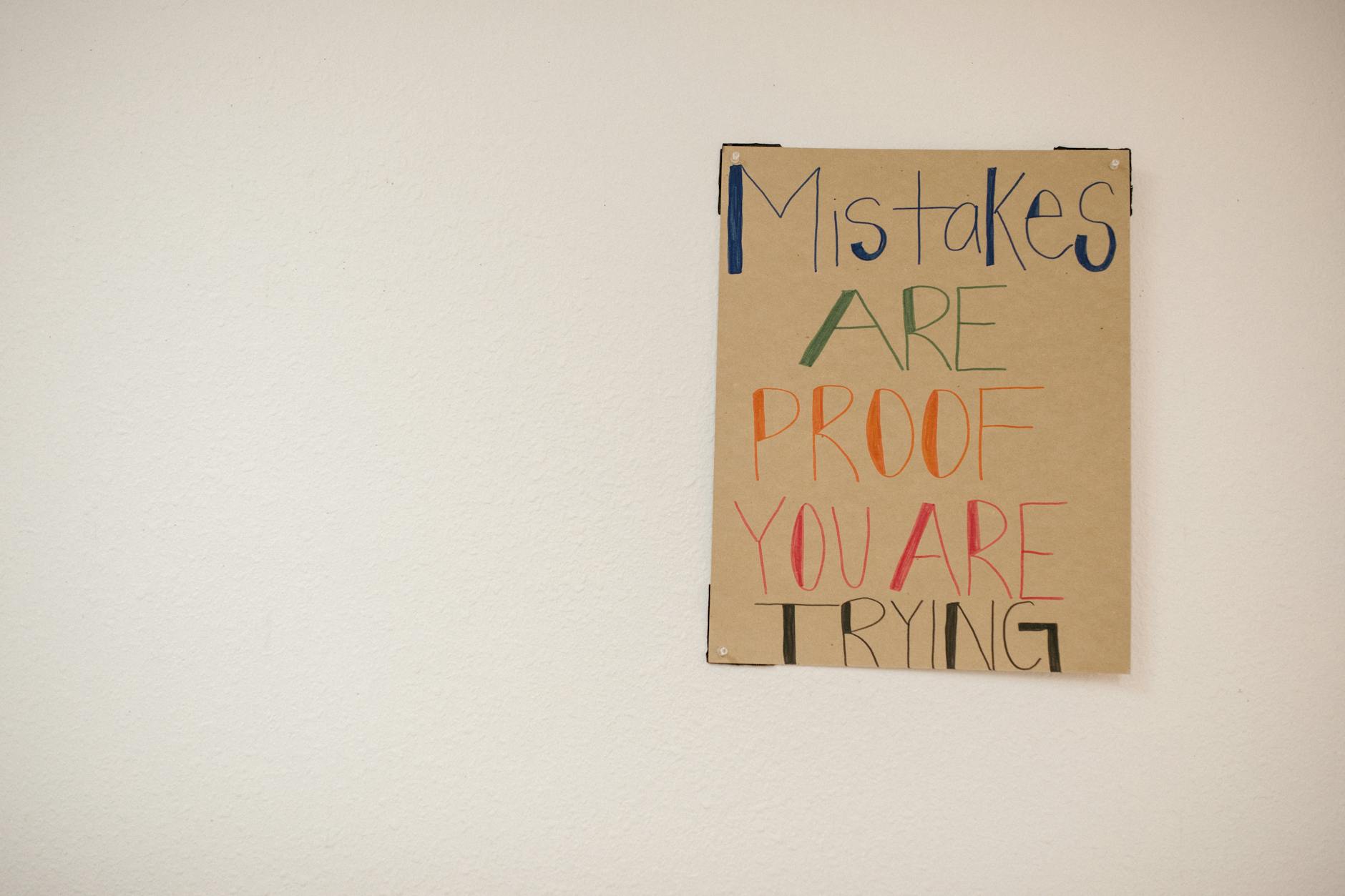Ever feel like Chinese grammar loves playing tricks on you? You're not alone. Even the sharpest IGCSE students fumble with misplaced measure words, sneaky sentence structures, or those pesky particles that seem to vanish mid-sentence.
This isn’t about memorizing textbook rules—it’s about spotting the actual slip-ups nobody warns you about. Think confusing complements, awkward adverb placements, and tones that change the game. By the end of this, you’ll be fixing these mistakes before they happen.
(Pro tip: If you’ve ever mixed up 了 and 过, you’re in good company.)
The Sneaky 的 (de) Particle
This tiny character is both clingy and forgettable—students either glue it everywhere or ghost it completely. 的 acts like linguistic glue, binding descriptions to nouns, yet somehow it keeps vanishing when needed most.

Photo by Jesse R
When to Use 的 (and When to Skip It)
- Attaching descriptions: "红色的苹果" (hóngsè de píngguǒ – red apple) needs 的 because it links the color to the noun.
- Ownership: "老师的书" (lǎoshī de shū – teacher’s book) demands 的 to show possession.
But skip it when:
- Single-syllable adjectives pair directly with nouns: "好人" (hǎo rén – good person), not "好的 人."
- Close relationships drop 的 for intimacy: "我妈妈" (wǒ māma – my mom), not "我的 妈妈."
Common Phrases Where 的 Is Overlooked
Students often forget 的 in these spots:
- Multiple adjectives: "又大又漂亮的房子" (yòu dà yòu piàoliang de fángzi – big and beautiful house) needs 的 to tie it all together.
- Generalizations: "学习的方法" (xuéxí de fāngfǎ – method of studying) loses clarity without 的.
For practice drills, Chinese Grammar with Rules and Interactive Exercises breaks down particle use.
The Confusing World of Measure Words
If numbers in Chinese were a party, measure words would be the strict bouncers—nothing gets in without one. Picture this: you confidently ask for "two coffee" (两咖啡), only to be met with blank stares. Why? Because you forgot 杯 (bēi – cup), the measure word police.
These tiny classifiers gatekeep every noun, and mixing them up is like serving soup with a fork—technically possible, but painfully wrong.

Photo by MART PRODUCTION
Top Measure Words Students Mix Up
Some measure words play favorites, while others refuse to be boxed in. Here’s where IGCSE students trip most often:
- 个 (gè) vs. 只 (zhī):
- 个 is the "default" measure word (一个人 – yí gè rén – one person), but 只 clings to animals (一只猫 – yì zhī māo – one cat).
- Danger zone: Using 个 for pets makes them sound like objects.
- 张 (zhāng) vs. 条 (tiáo):
- 张 flattens itself onto paper (一张纸 – yì zhāng zhǐ – one sheet of paper), but 条 stretches for long, thin things (一条路 – yì tiáo lù – one road).
- Plot twist: Pants use 条 (一条裤子), because logic.
- 本 (běn) vs. 部 (bù):
- 本 hugs books (一本书 – yì běn shū), while 部 prefers series or machines (一部电影 – yí bù diànyǐng – one movie).
For a full cheat sheet, the Chinese Measure Words List cracks the code.
How to Guess the Right Measure Word (When in Doubt)
Stuck without a measure word? Try these hacks:
- Shape theory:
- Flat things? 张.
- Long and noodle-like? 条.
- Chunky and round? 个.
- Anthropomorphism:
- If it’s alive (or was alive), 只 or 头 (tóu for livestock) usually works.
- The "gè" escape hatch:
- When in panic mode, 个 might save you—but expect native speakers to mentally correct you.
For ninja-level practice, Mango Languages’ measure word guide drills the patterns.
Tense? What Tense? Time Words in Chinese
Forget everything English taught you about verb conjugations. Chinese doesn’t twist verbs into knots to show tense. Instead, it drops time words like breadcrumbs to mark past, present, and future.
It’s like switching from a flip phone to a smartphone—different system, same goal. While English changes "eat" to "ate," Chinese just tacks on "yesterday" (昨天) and calls it a day. But students often trip over these time markers or force English grammar onto Chinese sentences. Let’s fix that.

Photo by Chris Liu
Key Time Words for Past, Present, and Future
Chinese time words are your GPS for navigating tense. Here’s the cheat sheet:
- Past:
- 昨天 (zuótiān) – yesterday
- 去年 (qùnián) – last year
- 以前 (yǐqián) – before
- 了 (le) – indicates completion (e.g., 我吃了 wǒ chī le – "I ate")
- Present:
- 现在 (xiànzài) – now
- 今天 (jīntiān) – today
- 常常 (chángcháng) – often
- Future:
- 明天 (míngtiān) – tomorrow
- 明年 (míngnián) – next year
- 会 (huì) – will (e.g., 我会去 wǒ huì qù – "I will go")
Watch how these transform a verb without changing it:
- 我昨天看书 (wǒ zuótiān kànshū) – "I read yesterday"
- 我明天看书 (wǒ míngtiān kànshū) – "I will read tomorrow"
Pro tip: Time words usually go right after the subject or at the start of the sentence.
Avoiding the English Tense Trap
The biggest blunder? Translating English tenses directly. For example:
- Wrong: 我吃饭了昨天 (wǒ chīfàn le zuótiān) – Literally "I ate yesterday," but with jumbled word order.
- Right: 我昨天吃饭了 (wǒ zuótiān chīfàn le) – "I ate yesterday."
Other common mistakes:
- Overusing 了 (le):
- 了 marks completion, not past tense. Don’t slap it on every past event:
- Wrong: 我去年是学生了 (wǒ qùnián shì xuéshēng le).
- Right: 我去年是学生 (wǒ qùnián shì xuéshēng) – "I was a student last year."
- 了 marks completion, not past tense. Don’t slap it on every past event:
- Ignoring time words:
- Relying solely on context risks ambiguity:
- 我买书 (wǒ mǎi shū) – "I buy books" (present) or "I bought books" (past)? Add 昨天 or 每天 (měi tiān – every day) to clarify.
- Relying solely on context risks ambiguity:
For deeper dives, Chinese Grammar Wiki’s time-word guide breaks down placement rules.
The fix? Train your brain to think in time markers, not verb changes. It’s like telling time with words instead of clock hands.
The Overlooked Art of Word Order
Chinese doesn’t just rearrange furniture—it flips entire rooms. While English lets you scatter time, place, and action haphazardly, Chinese demands a strict Time-Place-Manner sequence. Think of it as a sandwich: the bread (time) wraps everything, the filling (place) anchors the action, and the sauce (manner) adds flavor at the end.
Time-Place-Manner: The Golden Order
In Chinese, chronology rules. You can’t say you ate lunch after specifying the restaurant—time always marches first. Here’s the blueprint:
- Time (when?) → Place (where?) → Manner (how?) → Action (what?)
- 我昨天在食堂开心地吃饭 (Wǒ zuótiān zài shítáng kāixīn de chīfàn)
- "Yesterday, I happily ate in the cafeteria."
- 我昨天在食堂开心地吃饭 (Wǒ zuótiān zài shítáng kāixīn de chīfàn)
Common mistakes:
- English-style chaos: "I ate in the cafeteria yesterday happily" → 我在食堂昨天开心地吃饭 (wrong: place before time).
- Manner mid-sentence: "I yesterday happily ate in the cafeteria" → 我昨天开心地在食堂吃饭 (less natural).

Photo by Markus Winkler
Need practice? Chinese word order exercises drill this logic into muscle memory.
Questions? Flip the Order!
Asking "who ate my sandwich?" isn’t just about swapping words—it’s a full gymnastic flip. Chinese questions invert the usual order, parking the question word exactly where the answer would go.
Examples:
- Statement: 她昨天去了学校 (Tā zuótiān qùle xuéxiào) → "She went to school yesterday."
- Question: 她什么时候去了学校? (Tā shénme shíhou qùle xuéxiào?) → "When did she go to school?"
Spot the error:
- "Why you late?" → 你为什么迟到? (correct).
- "You why late?" → 你迟到为什么? (sounds robotic).
For question wizardry, the Placement of question words guide cracks the code.
Pro tip: Time and place still rule even in questions—never let them slip to the end.
Pitfalls of Direct Translation
Chinese and English speak different grammatical languages—literally. Word-for-word translations create sentences that sound like a robot malfunction. The problem? Your brain is wired to think in English, but Chinese demands its own logic.

Photo by RDNE Stock project
Funny (and Wrong) Translations Students Make
Ever tried translating idioms or phrases directly? Here’s what happens:
- "I very like Chinese" → 我很喜欢中文 (Wǒ hěn xǐhuān Zhōngwén) is correct, but students often say 我非常喜欢中文 (Wǒ fēicháng xǐhuān Zhōngwén), which sounds overly intense, like declaring love for Chinese in a Shakespearean soliloquy.
- "Open the light" (from English’s "turn on the light") → 开灯 (Kāi dēng) is correct, but direct translation creates nonsense like 打开光 (Dǎkāi guāng), which sounds like unpacking a box of sunlight.
- "How to say ‘how to say’?" → Meta, but wrong. Students often ask 怎么说话怎么说? (Zěnme shuōhuà zěnme shuō?), a word-for-word translation loop. The fix? Just ask 这个用中文怎么说? (Zhège yòng Zhōngwén zěnme shuō? – "How do you say this in Chinese?").
These mistakes aren’t just funny—they reveal a critical flaw: translating instead of thinking. According to the Cambridge IGCSETM Mandarin Chinese 0547 guide, direct translation is a top reason for lost marks.
How to Break the Translation Habit
Rewiring your brain takes practice. Here’s how to ditch the English crutches:
- Learn "chunks," not words:
- Instead of memorizing 喜欢 (xǐhuān) as "like," learn it as 很喜欢 (hěn xǐhuān – "really like"). Chinese relies on fixed phrases, not standalone words.
- Visualize, don’t translate:
- When you hear 猫 (māo), picture a cat—don’t mentally say "cat." This forces your brain to associate Chinese with meaning, not English.
- Shadow native speakers:
- Repeat sentences immediately after hearing them (like an echo). This trains your mouth to bypass English entirely. As noted in this Reddit discussion, immersion is key to stopping translation.
- Use sticky notes strategically:
- Label objects with Chinese phrases (e.g., 开门 kāi mén – "open the door") instead of single words.
Struggling? You’re not alone. A Mandarin HQ guide admits even advanced learners fight translation urges. The fix? Treat Chinese like a musical instrument—practice until your fingers (or tongue) move without sheet music.
Conclusion
So there you have it: five IGCSE Chinese grammar traps that sneak up on even the savviest students. To recap, watch out for the clingy 的 particle, measure word mix-ups, time words doing tense’s job, word order reversals, and the direct translation trap.
The good news? Even native speakers fumble these sometimes. The better news? Now you know how to catch them before they trip you up.
Here’s your challenge: Scan your next homework or practice essay for these exact mistakes. Bet you’ll spot at least one. And when you do, give yourself a pat on the back—you just leveled up.
Stick these rules in your brain, and they’ll stick with you through the exam. Happy grammar hunting.
5 IGCSE Chinese Grammar Mistakes Every Student Makes